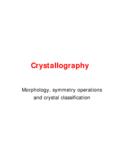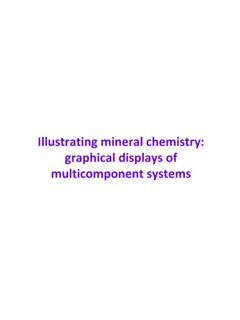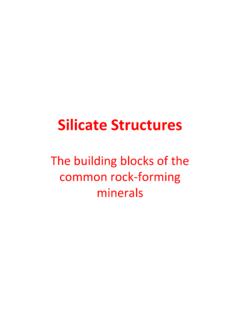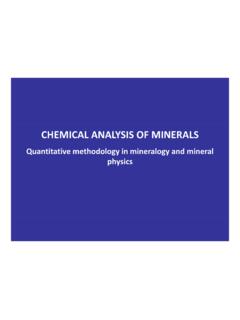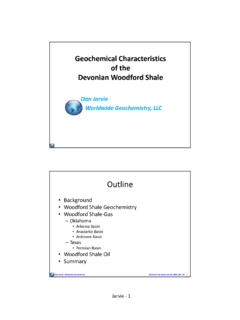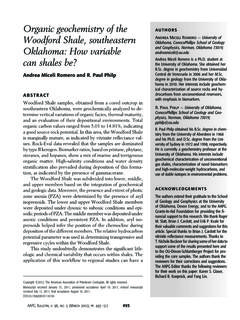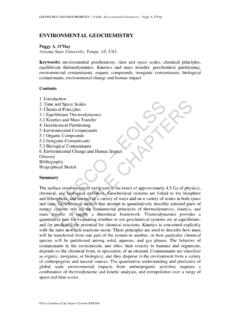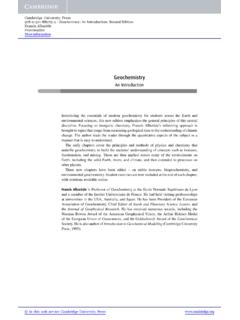Transcription of AQUEOUS AND ENVIRONMENTAL GEOCHEMISTRY - …
1 Geosciences 519 Spring, 2011 AQUEOUS AND ENVIRONMENTAL GEOCHEMISTRY Richard F. Yuretich 138 Morrill 545-0538 Office Hours: M 1:30 2:30 Tu 11:00 12:00 Class Meetings: T,Th 9:30-10:45 (Lab) T 2:30-5:30 Course Goals and Structure This course deals with the natural and human influences on water composition in the Earth's near-surface environments. Our concern will be primarily with fresh water, streams, lakes, and groundwater, although we will explore some continental saline environments. In all cases, we want to examine the chemical and geological processes that govern the concentration levels of dissolved substances in AQUEOUS systems, and in the course of this endeavor you will employ equilibrium thermodynamics as a problem-solving framework; develop proper, careful and accurate skills in laboratory and analytical methods; operate modern analytical instrumentation ; interpret the behavior of naturally complex geochemical systems; use computer programs designed to unravel chemical speciation in natural systems; apply your knowledge to field-based projects in surface- and ground-water systems; experience the process of designing an investigation in AQUEOUS GEOCHEMISTRY .
2 Become familiar with the journals and technical sources in the subject; explain your findings and conclusions to your peers; write about geochemical investigations clearly and accurately. Much of the class time during "lecture" will be devoted to discussions and analyses of readings and problems to better understand the fundamental chemical and geochemical concepts. Consequently, you must come to class prepared by reading the appropriate book chapters and attempting to work the assigned problems. This way, you will be a full partner in the learning enterprise. Class attendance is an important part of the process, so there will be a penalty for each class absence beyond three. AQUEOUS and ENVIRONMENTAL GEOCHEMISTRY , Spring 2011 2 Products and Assessment There will be two major products used to assess your understanding of the concepts and applications of GEOCHEMISTRY .
3 The first will consist of a take-home mid-term exam, which will allow you to interpret the significance of geochemical data. Although you may collaborate in working through the solutions, each of you will hand in your own written interpretation. During the second half of the semester, we will focus on a field-based project to investigate aspects of a watershed geochemical system. You will be involved in the research design, data analysis, and interpretation of the results. For the project, each research team will give an oral presentation outlining the major findings and interpretations and each team member will produce a comprehensive written report about his or her contribution to the project. The goal of the presentations is to give the other research teams an opportunity to learn from the experiences of their colleagues, and compare the approach and methods used in the project.
4 There will also be weekly ( ) problems and written assignments that can be done collaboratively, but will be handed in and assessed individually. During the first half of the semester, we will also have a few traditional laboratories to help learn analytical skills, for which you will hand in a brief report. There will be no conventional exams in this course. The general scheme for assigning grades is as follows: Take-home Midterm 25% Research Project 35% Weekly Assignments 20% Initial Lab Reports 10% Attendance 10% All products will be evaluated on the basis of scoring rubrics, which will be distributed in advance. Projected Schedule Owing to the fluid (no pun intended!) structure of the course, assigning specific topics for specific days is a little premature.
5 However, we do want to make sure that you learn the essential concepts of GEOCHEMISTRY , so we will use the following schedule to guide or discussion and problem-solving during class time Dates Focus Text Jan. 18, 20 . Introduction; Geochemical Principles Chap. 1 Jan. 25, 27 Basic Thermodynamic Relationships Chap. 2 ( ) (Lab) Orientation and Safety AQUEOUS and ENVIRONMENTAL GEOCHEMISTRY , Spring 2011 3 Feb. 1, 3 Activity and Equilibrium Chap. 2 (p. 37-49) (Lab) Collection of first samples Feb. 8, 10 Acidity and pH Chap. 3 (p. 59-75) (Lab) pH and activity Feb. 15, 17 Alkalinity and the CO2 system Chap.
6 3 (p 75-90) (Lab) Potentiometric Titrations Feb. 24 (Thurs.) Principles of Oxidation and Reduction Chap. 4 (p. 94 110) Mar. 1, 3 (Lab) Redox Measurements Mar. 8, 10 Controls on Composition of Natural Water Chap. 8 ( ) (Lab) ICP Spectrophotometry Mar. 15, 17 SPRING RECESS Mar. 22, 24 Water chemistry and geology Chap. 9 ( ) (Lab) Ion Chromatography Mar. 29, 31 Equilibrium Models Reading to be (Lab): Using Water Chemistry Models assigned Apr. 5, 7 Organics in Natural waters Chap. 5 ( ) (Lab) Field Excursion (weather permitting!)
7 Apr. 12, 14 Adsorption and Complex Formation Chap. 9 ( ) (Lab): Project Analyses Apr. 19, 21 Metals in the Environment Chap. 9 ( ) Lab: Project Analyses May 3, Project Reports AQUEOUS and ENVIRONMENTAL GEOCHEMISTRY , Spring 2011 4 Resources Textbook: Eby, , 2004, Principles of ENVIRONMENTAL GEOCHEMISTRY , Thomson Brooks/Cole, Pacific Grove, CA 514 p. Other useful references: Appelo, and Postma, D., 1993, GEOCHEMISTRY , Groundwater and Pollution; Balkema, Rotterdam; 536 p. Domenico, and Schwartz, , 1998, Physical and Chemical Hydrogeology (2nd edition); John Wiley & Sons, New York; 506 p.
8 Drever, , 1997, The GEOCHEMISTRY of Natural Waters (3rd edition); Prentice-Hall, Englewood Cliffs, NJ, 436 p. Garrels, and Christ, C., 1965, Solutions Minerals and Equilibria; Freeman, San Francisco; 450 p. Langmuir, D. A., 1997, AQUEOUS ENVIRONMENTAL GEOCHEMISTRY ; Prentice-Hall, Upper Saddle River, NJ., 600 p. Merkel, and Planer-Friedrich, B., 2005, Groundwater GEOCHEMISTRY ; Springer-Verlag, Berlin, 200 p. Pankow, , 1991, Aquatic Chemistry Concepts; Lewis Publishers, Chelsea, MI; 683 p. (not in library) Salomons, W. and F rstner, U., 1984, Metals in the Hydrocycle; Springer Verlag, Berlin, 349 p. Stumm, W. and Morgan, , 1996, Aquatic Chemistry (3rd edition); Wiley-Interscience, New York; 1022 p.
